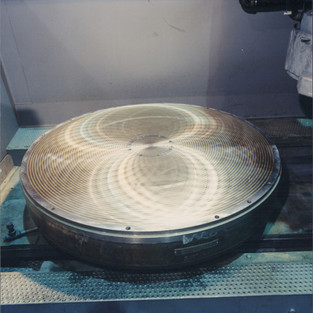From our Magna-Lock USA archives, a discussion of rotary electromagnetic chuck types and comparison of Mattison and Blanchard chucks.
To illustrate a point I wish to make, let’s for a moment assume we were asked to engage in an in-depth study of the clothing industry. Of the many types of clothing on the market, how would you prepare a simple logical outline of the many classifications applicable to clothing? Should our major divisions be woman’s clothing vs. men’s clothing? Or should our major divisions be outerwear vs underwear? Or should we start with formal vs. casual wear? Or we might consider groupings on the basis of fabrics, or colors, or many other characteristics. I’m sure you’re ready to admit the outlining of the broad product category “clothing” would be a horrendous task.
There are really few rotary chucks that might be considered standard.
Well, rotary electromagnetic chucks are probably equally difficult to arrange in an outline form where there are neat pigeonholes to accommodate each and every type. I believe that is because the term “rotary chuck” is just too broad—so broad it doesn’t really define anything except that the general configuration of these chucks is circular. Secondly, the majority of Magna-Lock USA rotary magnetic chucks have been specially designed, made to order for a specific workpiece and/or machine. There are really few rotary chucks that might be considered standard. The major exceptions are, of course, the concentric ring rotary chucks manufactured for Mattison rotary table surface grinders.

Historical Background
It seems necessary to touch on the history of the electromagnetic rotary chuck product line and I’d like to think this helps us understand why we do or don’t do certain things with the products under consideration. I’ll go back to somewhere around the late 1930’s or early 1940’s, the early World War II days. At that particular time—and it still holds true today—the leading manufacturer of vertical spindle, rotary table surface grinders in the USA was the Blanchard Company. In fact, their machines were so widely accepted that this type of grinding was commonly referred to as “Blanchard Grinding,” a misnomer which persists to this very day. At this same point in time a similar grinder was also manufactured right in Big Rapids, Michigan by the Hanchett Manufacturing Company. Incidentally, both Blanchard and Hanchett manufactured their own concentric ring rotary electromagnetic chucks used on the work tables of their machines. Previously, I’ve explained how in late 1948, the Hanchett rotary table surface grinder business was sold to Mattison Machine Works in Rockford, Illinois, where the machines were continued to be manufactured until the 1990’s when Mattison closed. You’ll remember that it was also at the same time in late 1948 that the Hanchett Company sold their magnetic chuck line to result in the formation of Hanchett Magna-Lock, the forerunner of the present Magna-Lock USA brand. And Magna-Lock had been virtually the sole supplier of rotary magnetic chucks for Mattison’s grinders.
The Mattison design has some distinct advantages over the Blanchard concept.
The differences in the chucks of the 1980’s and the chucks of the 1940’s for Mattison grinders would be barely discernible to the naked eye, except that the most popular size in the 1980’s was the 42” diameter chuck. Back in the 1940’s, the most popular size jumped back and forth between the 30” and 36” diameter chucks. Other familiar popular Mattison sizes include 48”, 54”, 60”, 84”, and 96” diameter; and occasionally we have supplied 90”, 108”, 120”, 144”, and 168” diameter chucks.
Rotary electromagnetic chucks are by no means limited to concentric ring top plate patterns.
Mattison vs. Blanchard Rotary Chucks
There is an important difference between the chucks manufactured for Mattison rotary grinders and the ones built by Blanchard for their machines. The Mattison chucks are complete units, integral assemblies which are then simply mounted on the round table of the grinder. But in Blanchard grinders the base plate of the magnetic chuck serves as the machine table. This member contains the table bearing surfaces and drives gear seats on its underside; and the chuck body/top plate member, a one-piece forging, is then attached to the upper surface of the table member. In our opinion, the Mattison design has some distinct advantages over the Blanchard concept:
1. SERVICING IS MORE CONVENIENT – Removal of Mattison chucks is simple. A few socket head cap screws are removed from two bolt circles, the brushes are disengaged, and then the entire chuck can be removed from the machine table, making it a simple matter to exchange chucks when the need arises. Changing chucks on a Blanchard machine requires considerable dismantling of the machine, enough to make it a major overhaul job. So in the event of chuck problems, machine downtime would be minimized with the Mattison grinder.
2. COLLECTOR RING/BRUSH HOLDER ACCESSIBILITY-In the Mattison rotary chucks the collector ring is in a bore running through the center of the chuck. A removable cover in the top of the chuck allows for periodic inspections and servicing of the collector rings and brushes without removing the chuck from the machine. Blanchard’s design is such that it becomes necessary to remove the entire chuck to get to the collector ring and brush holder.
3. REPLACEABLE TOP PLATE-About the only portion of a rotary magnetic chuck subject to “wear” is the top plate. From time to time it becomes necessary to regrind the chuck surface to restore surface finish and flatness. This may remove from as little as .002” to as much as .040” or more of material and is done right in the machine on which the chuck is installed. After repeated redressings, the top plate thickness may be reduced to where it is no longer adequate magnetically, or structurally. The Mattison chucks are designed with removable top plates, so it is possible to return the chuck to Mattison and have the faulty top plate replaced at about 40% of the price of a similar chuck. With the Blanchard design, the top plate and body are machined from a single piece of steel. At one time, the only replacement available was to buy a completely new chuck, a very expensive and time-consuming procedure. Engineers from Magna-Lock in the 1970’s and 1980’s, however, devised a procedure for re-working “worn-out” Blanchard chucks in which it was possible to salvage the rings from the chuck body and to fabricate a new top plate. This costs more than top plate replacements for Mattison-type chucks but is still considerably less than the price of a new Blanchard chuck.
4. IMPROVED QUALITY THROUGH UNITIZED CONSTRUCTION-Because the Mattison rotary chucks are complete in themselves, they can be pretested with the assurance that result in the field will not be affected due to matching up a specific body/top plate assembly with an entirely different base plate/machine table member. More importantly, the completely assembled chuck design lends itself to factory stress relieving to assure improved stability in the field. Also, with the Mattison chuck design there is less chance of shipping damage, because the coils and wiring are completely enclosed and protected.




Other Rotary Chuck Patterns
Rotary electromagnetic chucks are by no means limited to concentric ring top plate patterns. Magna- Lock USA have manufactured a variety of other designs and modifications. Time does not permit an in-depth study of each of these concepts, but some of the better-known types have been included in the following list:
A. Radial Pole – a pattern of radial spoke-like non-magnetic separators dividing the pole pieces into pie-shaped segments.
B. Heavy-Duty Crossover – a modification of the conventional radial pole pattern, generally with one pair of parallel non-magnetic separators at right angles to a similar second pair of parallel separators. The cross shaped area between the two pairs of separators becomes one magnetic polarity, while the four remaining circular segments are of the opposite magnetic polarity.
C. Clover-Leaf – still another form of radial pole pattern in which the path of the single non- magnetic separator describes the outline of a multi-leaf clover. The area within the separator is one magnetic polarity and the area outside the separator is the opposite polarity.
D. Tear Drop – a modification of clover-leaf pattern, except there is a symmetrical pattern of lobed pole pieces each with its individual non-magnetic separator totally enclosing it.
E. Staggered Pole – commonly used on Arter grinders. Can be considered another of the clover- leaf modifications, except that the separators’ outlining the clover leaves describe a severely accented serpentine pattern. You could say the clover leaf becomes a maple leaf.
F. Straight Chordal Laminated – with a parallel laminated pole pieces and separators, resembling a circular piece sawed out of a conventional rectangular laminated chuck.
G. Grid Style – grids and fingers (like those in rectangular grid style chucks) arranged in a geometric pattern.
Magna-Lock USA has manufactured a variety of other designs and modifications.
_edited.png)




























































